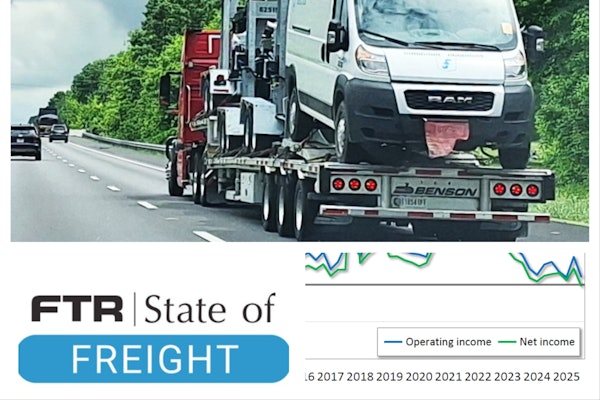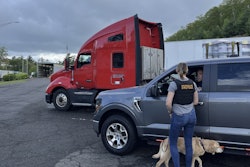Trucking news and briefs for Wednesday, Aug. 21, 2024:
Drug busts: Contraband found in loads of celery, watermelons, more
U.S. Customs and Border Protection (CBP) has been busy across the Southern border recently, with several reports of commercial trucks caught with drugs attempting to cross into the U.S.
On Friday, Aug. 9, CBP officers at the World Trade Bridge in Laredo, Texas, seized $6.5 million in hard narcotics from a truck hauling a load of flowers.
A CBP officer referred a 2023 Freightliner hauling a refrigerated trailer manifesting a commercial shipment of flowers for secondary inspection. Following a canine and non-intrusive inspection system examination, officers discovered a total of 712.54 pounds of alleged methamphetamine within the load. The narcotics combined had a street value of $6,551,910. CBP seized the narcotics. Homeland Security Investigations special agents are investigating the seizure.
At the Otay Mesa, California, Commercial Facility, CBP officers made the largest fentanyl bust of the fiscal year in the state. Fentanyl and cocaine were found in a non-factory compartment of a flatbed trailer.
 CBP officers found 360 pounds of fentanyl and cocaine hidden within a flatbed trailer.Photos by U.S. Customs and Border Protection
CBP officers found 360 pounds of fentanyl and cocaine hidden within a flatbed trailer.Photos by U.S. Customs and Border Protection

“This record-setting seizure is a stark reminder of the ongoing battle against drug trafficking,” said Rosa Hernandez, CBP Port Director for the Area Ports of Otay Mesa. “Concealing such a staggering quantity of fentanyl and cocaine within a flatbed trailer shows the lengths traffickers will go and further showcases the exceptional vigilance and hard work our officers perform on a daily basis.”
Another bust on Aug. 9 at the Otay Mesa facility revealed 629 pounds of methamphetamine concealed within a shipment of celery.
During secondary inspection, the shipment of celery was offloaded for closer scrutiny. A CBP K-9 unit was brought in to screen the produce and quickly alerted officers to the presence of narcotics. Upon careful inspection, officers uncovered 508 packages hidden amongst the celery. Testing confirmed the packages contained methamphetamine, with a total weight of 629.72 pounds and an estimated street value of $755,000.
 CBP officers found 4,587 pounds of meth in shipment of disguised watermelons.
CBP officers found 4,587 pounds of meth in shipment of disguised watermelons.
In the secondary inspection area, the watermelon shipment was offloaded to the intensive dock for further examination, where officers uncovered 1,220 packages wrapped in paper, disguised as watermelons within the shipment. The contents of the packages were tested and identified as methamphetamine, with a total weight 4,587 pounds. The estimated street value of the drugs exceeds $5 million dollars.
[Related: Rates slip back from June gains | Truck driver pleads guilty to drug trafficking]
Traffic light priority system now live for truckers in North Texas
A system now operational in North Texas will help truck drivers cut down on time spent sitting at red lights and improve freight efficiency in the region.
The North Central Texas Council of Governments’ Freight Priority program recently launched a mobile app for truck drivers that connects the truck to the cloud, where the GPS location of the vehicle is shared with the EcoDrive app and Smart Priority software and is disseminated to the traffic signal priority system. The information is then used to extend traffic signal phases by a few seconds to keep trucks moving.
The app provides drivers with an optimized speed advisory, which is the recommended speed they should drive to be able to traverse a group of traffic lights on green. It also lets drivers know when the end of a green phase is coming so they can slow down. The signal priority system can extend a green light and truncate a redlight so a truck can get through without making a stop, which costs time, fuel and emissions.
The free Freight EcoDrive app is available for download on the Google Play store for Android and the Apple App Store.
[Related: Texas-based project would give freight trucks priority at red lights]
Waste Management seeks waiver from certain clearinghouse requirements
Waste Management Holdings (WMH) is petitioning the Federal Motor Carrier Safety Administration for an exemption from certain driver qualification requirements and drug and alcohol clearinghouse regulations when its drivers are transferred among two or more WMH carriers with different USDOT numbers.
The company said the waiver would remove the administrative burden of requalifying already qualified drivers every time they are reassigned among related WMH motor carrier affiliates.
As part of its residential and commercial trash and recycling collection and waste disposal services, WMH employs tens of thousands of commercial motor vehicle drivers among its affiliates, which operate under 83 USDOT numbers. It has centralized USDOT compliance efforts across all its related carriers under its Employment Screening Program (ESP), and critical compliance processes and documents are managed through centralized information technology systems, the company added.
“WMH asserts that the existing driver qualification and drug and alcohol testing rules fail to contemplate the types of intercompany driver transfers that WMH's operations necessitate, leading to severe administrative inefficiencies, record duplication, and an inability to respond timely to surges in demand for waste removal, which often occur following natural disasters, public health emergencies (such as the recent COVID pandemic), mass gatherings or events, infrastructure failures, community clean-up efforts, industrial accidents or spills, or regional disruptions,” FMCSA said of WMH’s request in a Federal Register notice publishing Thursday, Aug. 22.
[Related: Sleeper berth: Should more truckers be able to split as they see fit?]
Under current regulations, WMH has to require transferred drivers to complete new employment applications, contact previous employers, run new motor vehicle records, query the drug and alcohol clearinghouse, analyze whether pre-employment drug testing is necessary and perform testing if required, and create new qualification files, all of which can take several days to complete and may delay or deter the transfer, the company said.
The centralization of its driver qualification and drug/alcohol testing processes, policies, and documents under its ESP Department across all its affiliated carriers maintains an equivalent level of visibility into the drug/alcohol clearinghouse status of all drivers across its entire organization, WMH added.
FMCSA is accepting public comment on the request for 30 days beginning Thursday at www.regulations.gov by searching Docket No. FMCSA-2024-0200.











